Tuesday, August 14. 2007
On Maggie's Farm, our Jewelweed (aka Touch-Me-Not) is now in bloom everywhere there are damp, semi-shady spots. Where there is Jewelweed, there will be Ruby-Throated Hummingbirds if you sit down and watch. 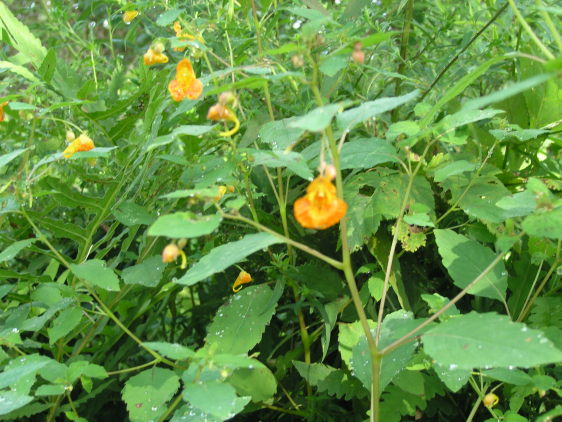
Saturday, August 11. 2007
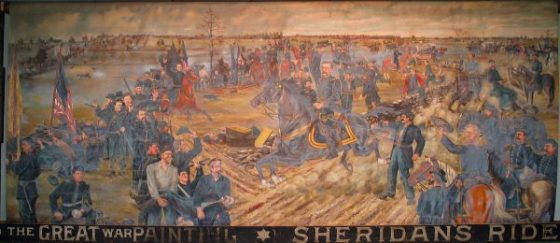
Gen. Philip Sheridan, an avid hunter and ornithologist, played a large role in the early conservation movement, especially at Yellowstone. Painting: Sheridan's famous 20-mile ride from Winchester VA to Cedar Creek, on his war horse Rienzi. The Union victory at the Battle of Cedar Creek helped an unpopular Lincoln gain re-election by a war-weary nation. Every school kid once knew this poem.
Wednesday, August 8. 2007
 We posted this well-known presentation by Michael Crichton a year ago, but I was recently reminded of it by the Assistant Village Idiot who cops to finding complexity to be complicated. We posted this well-known presentation by Michael Crichton a year ago, but I was recently reminded of it by the Assistant Village Idiot who cops to finding complexity to be complicated.
If you haven't read it, please do. It's an excellent discussion of how complicated nature is, and how readily our human good intentions can produce serious unintended consequences. Good graphics, too.
Wednesday, August 1. 2007
I cannot explain why we are re-posting this bit from last year's Bovine of the Week Series. Just accept that there is a good reason. 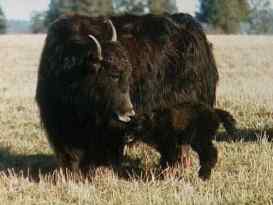 Yes, unlike the Musk Ox, the Yak is a bovine, and a cousin of the ancestor of our Western domestic cattle, the mighty Auroch. Yes, unlike the Musk Ox, the Yak is a bovine, and a cousin of the ancestor of our Western domestic cattle, the mighty Auroch.
Yaks come in a wild and domesticated form. 85% of these cold-climate creatures are said to be in China, and are still used for plowing, meat, milk, wool, and as beasts of burden. They are capable of hybridizing with domestic cattle, yielding a breed which is commonly used as a pack animal in Tibet. Why yurts with yaks? They begin with a Y. Yurts are Mongolian houses, of course, but I recently learned that you can buy plans for them, and the structures, from several American manufacturers, such as Pacific Yurts. Cozy dwellings for snowy places, cheap and practical - but I'll take a log cabin.
Tuesday, July 31. 2007
You can't really find vast fields of wild Lowbush Blueberry south of Maine. They especially seem to grow where there has been forest fire or clear-cutting. Always keep an eye out for bears in a lowbush blueberry field. And Rightly So has a little photo essay on the subject. Here's one of her fine photos: 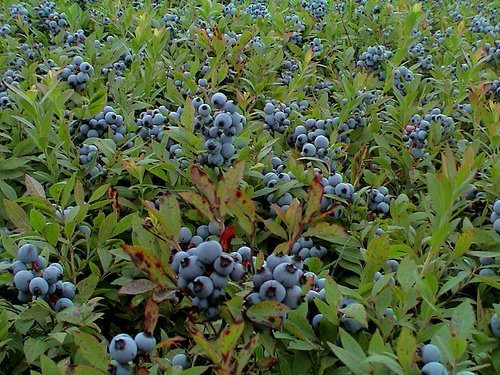
Monday, July 30. 2007
This moth on a window (thanks, reader) reminds me of Billy Gibbons, with the RayBans and the dirty beard. I think I'll post a ZZ Top tune (below). Correction: That is two moths, facing in opposite directions, mating. It's more farm p*rn from Maggie's Farm. I did think the leg count was strange. 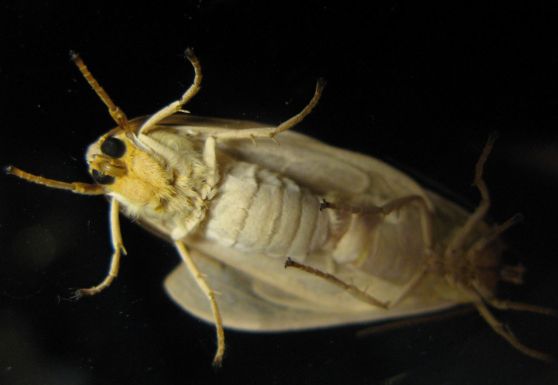
Monday, July 23. 2007
Who is falling for it? Not us. But it has become the latest hot marketing ploy. Once some pop trend becomes an auto-marketing plan, you know it's over as an idea. (h/t, Junk Science)
Saturday, July 21. 2007
Blackfish Creek is a tidal inlet which runs from the harbor through the town of Wellfleet, MA. Photo borrowed from this Wellfleet photo site. 
Friday, July 20. 2007
Regular readers know that Maggie's Farm has a strong conservationist orientation, but if anyone tries to call us Greenies we will shoot you in both kneecaps with our Colt Python. I know some readers are inclined to disagree with us about this, but we do believe in certain sorts of planning, and even certain sorts of government "taking," Kelo notwithstanding. 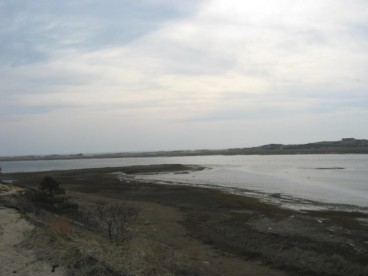 For two examples we like, JFK's Cape Cod National Seashore took the development rights to broad swaths of the Lower Cape (which is the upper Cape). This action not only preserved the feel and aesthetics of the Cape but preserved the unusual Cape environment - and ultimately raised land values through the roof. Without the National Seashore, there would no longer be anywhere on the Cape to hunt, the salt marshes would be filled in, and the place would look like the worst parts of the Jersey Shore. (Photo is a view of Wellfleet's Chequessett Neck). For two examples we like, JFK's Cape Cod National Seashore took the development rights to broad swaths of the Lower Cape (which is the upper Cape). This action not only preserved the feel and aesthetics of the Cape but preserved the unusual Cape environment - and ultimately raised land values through the roof. Without the National Seashore, there would no longer be anywhere on the Cape to hunt, the salt marshes would be filled in, and the place would look like the worst parts of the Jersey Shore. (Photo is a view of Wellfleet's Chequessett Neck).
Another example we like is Britain's Town and Country Planning Act of 1947. Without that act of Parliament, Britain would not be a tourist destination: it would look like Indianapolis. It protected the towns, and it protected their farmlands and open spaces. Yes, it essentially confiscated development rights - with the voters' approval. (Photo below: A view of English countryside, just outside of town.) 
So, while our pure Libertarian readers grouse and grumble, let's get to the point. The good Prof. Pat Deneen recently hosted Roger Scruton at Georgetown, which speech is now Scruton's most recent published essay, A Righter Shade of Green, in The American Conservative. Scruton isn't so much in favor of government taking - he is in favor of a local sense of trusteeship. That's the right idea, but I haven't seen it work in practice too often: local politics are not the highest form of human civic evolution or future-orientation. As Prof Deneen notes, and as we have frequently noted here, poor stewardship of our precious land in the US is made possible by the "externalization of costs" to other people and to future generations. Example: highways. Example: development of good farmland for 1/2 acre zoning. Read Pat Deneen's piece here. He quotes Scruton's conclusion: What then is the conservative solution, if there is one? A revival of trusteeship is the only hope for the future, and this attitude is natural to human beings. They enter the world through no choice of their own, to be greeted, as a rule, by the love of parents and the security of home. The trustee is the one who recognizes that his home, and all that it means, are inherited things, things to be safeguarded and passed on. This attitude exercises itself at the local level in the voluntary associations and small institutions of civil society. It is the core component in that associational genius that Tocqueville discerned in the American people. It is the legacy of a political order that regards people, not rulers, as the source of authority and the fount of responsible decision-making.
Environmental movements on the Left seldom pause to consider the question of human motivation. It is so clear to them that something must be done that they leap to the conclusion that it must be done by state power and imposed by law. The problem with that approach is that it makes mistakes into permanent legacies and provides no incentive to ordinary citizens to do what they are told. Conservatives, on the whole, are more respectful of human nature and will recognize in the attitude of trusteeship a feeling to which we automatically tend, when given the freedom to exercise it.
Read Scruton's whole essay at American Conservative.
Tuesday, July 17. 2007
Morning mist rising at 6 am in New Hampshire's White Mountains on Sunday. Thanks, reader. 
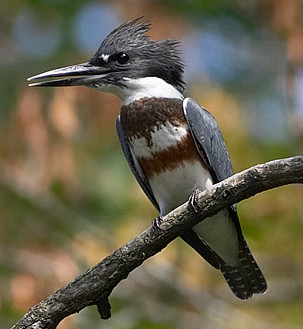 All summer we see and hear the sturdy Belted Kingfishers rattling up and down the stream with their dipping flight pattern, hunting for minnows and small water critters. During migration, I have seen them around salt water inlets too, but I think they prefer freshwater streams. All summer we see and hear the sturdy Belted Kingfishers rattling up and down the stream with their dipping flight pattern, hunting for minnows and small water critters. During migration, I have seen them around salt water inlets too, but I think they prefer freshwater streams.
I have no idea where they have dug their nest: they dig nest holes in banks, and are highly territorial. Our Belted Kingfisher is found across the US and Canada, and there are a number of species of Kingfishers found around the globe. Another bank-nester is the drab Bank Swallow, which nests in colonies near water. I have only seen a couple of Bank Swallow colonies in New England - one of them had about a hundred nests - and they are very local in distribution, unlike the Kingfisher. Apparently man has expanded their distribution because road-cuts provide good cliffs for their nest holes. Photo: A female Kingfisher. The males don't have the red band.
Thursday, July 12. 2007
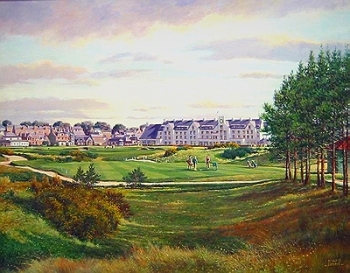 We linked the article at Science Daily about how golf courses can, with a little effort, turn their vast open spaces into wildlife sanctuaries without damaging the golfing. Turns out 70% of a golf course isn't really walked on. We linked the article at Science Daily about how golf courses can, with a little effort, turn their vast open spaces into wildlife sanctuaries without damaging the golfing. Turns out 70% of a golf course isn't really walked on.
Well, it's a movement. The Audubon Cooperative Sanctuary System now includes 78 golf courses worldwide. Maybe it is many more, now. Here's an OSU Extension piece on the subject. Here's an Audubon International piece. The idea is great because it is both modern and old-fashioned: golf evolved on the wild moors of Scotland in harmony with the native scenery, and not in a sterile environment like a glorified version of miniature golf. Image: 16th hole at St. Andrews
Sunday, July 1. 2007
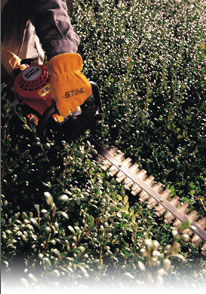 We have written many times about how using ethanol (alcohol, aka moonshine) as a gas additive is a scam, and nothing more than a massive farm subsidy which is raising the cost of food. We have written many times about how using ethanol (alcohol, aka moonshine) as a gas additive is a scam, and nothing more than a massive farm subsidy which is raising the cost of food.
But I just learned more. When you use gas with ethanol, it can destroy your gas-powered power tools and mowers. I just had a conversation with my local Stihl and Scag dealer yesterday - my Stihl hedge trimmer needed a new carburetor. Guy said the ethanol kills these machines - their lines, their carburetors, etc. He says it's also murder on outboard engines. He explained that it's less of a problem for pros who use their tools daily, but if you use your tools occasionally, the alcohol - being water-soluble - separates from the gas and makes a mess. The new carburetor cost me $97. His advice: Run the machine down to empty if you aren't going to use it for a while, and always use fresh gas - don't use two-month-old gas. If you are like me, you have five gallon containers of vintage gas-oil mix left over from last fall. Get rid of it, somehow. Here's one article on the subject.
Thursday, June 28. 2007
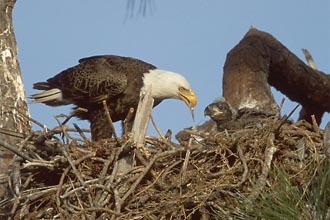 The return of the Bald Eagle is a satisfying success story. The return of the Bald Eagle is a satisfying success story.
With the banning of DDT, protection from idiot shooters, and the transplantation of chicks, the big fish-eaters will be around the US for our kids to see. This bird can be found, in small numbers, almost everywhere in the US where there are large bodies of water, except in mountains. 10,000 nesting pairs in the lower 48 isn't much, but it's lots more than the 400 in the 1960s. Read about the Bald Eagle here.
Wednesday, June 27. 2007
One of the pups just got back tonight from a little pre-beginning-real-job jaunt to Beaver Creek, with photos in hand, as requested. 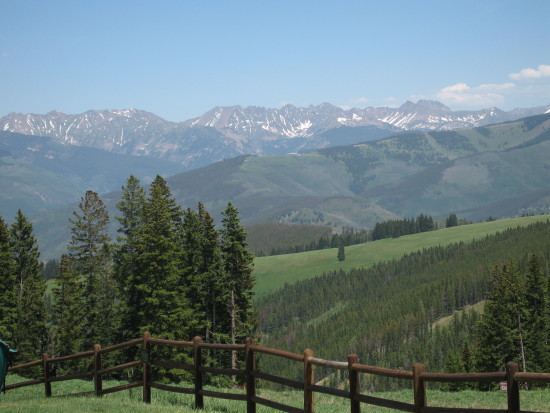
Wednesday, June 20. 2007
 750 lb. male Griz caught in Montana, collared, and released, near beautiful Choteau, MT - "The Paris of the Rocky Mountain Front." 750 lb. male Griz caught in Montana, collared, and released, near beautiful Choteau, MT - "The Paris of the Rocky Mountain Front."
In reality, if he was looking for a decent meal then downtown Choteau is not the place, but you can buy cigareets and whusky there. I have been there.
Friday, June 15. 2007
 Maggie's Farm supports and admires the work of The Land Trust for Tennessee - as we do the good work of all land trusts. Maggie's Farm supports and admires the work of The Land Trust for Tennessee - as we do the good work of all land trusts.
Photo from yesterday's celebration of a donor of a conservation easement on her working farm. Some things in life mean more than money. Yes, Maggie's Farm has had a conservation easement for a number of years, and can never be developed. Nice old farmhouse. What style would ya call that, Sippican? Sippican: It's "a nice little spindle-style Queen Anne house, a little spare on the embellishment."
Thursday, June 14. 2007
The destruction of America's egret population was one of the reasons for the creation of the Audubon Society. The special breeding-season egret plumage made great decorations for ladys' hats. Our egret populations have recovered nicely. If you have a rookery anywhere nearby, where often many species of egrets nest together, you are fortunate because you will see these fellows all the time, stalking for food in the shallows. When you see a Snowy, watch for those bright-yellow feet on their black legs. Like Mickey Mouse. You can read about the Snowy here. (thanks, reader, for the nice photo) 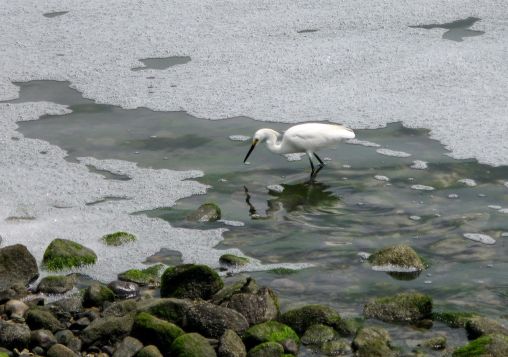
Tuesday, June 12. 2007
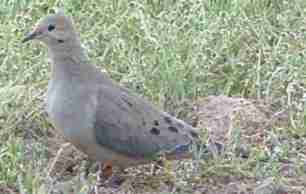 Now that we are in June, our birds would rather eat bugs than seeds. Regardless, I am continuing the feeder this summer to see who stops by. Today: Purple Grackles, Mourning Doves in droves, Goldfinch, Redwing Blackbird, Cowbird, House Finch, House Sparrow, Blue Jay, Cardinal, Tufted Titmouse. Oh - of course, Grey Squirrels. Now that we are in June, our birds would rather eat bugs than seeds. Regardless, I am continuing the feeder this summer to see who stops by. Today: Purple Grackles, Mourning Doves in droves, Goldfinch, Redwing Blackbird, Cowbird, House Finch, House Sparrow, Blue Jay, Cardinal, Tufted Titmouse. Oh - of course, Grey Squirrels.
Lurking happily in the rose bushes under the bird feeder: 2 baby Cottontail rabbits and a family of Chipmunks. The young bunnies are too tame and trusting for life, so I try to teach them basic survival fear by advancing menacingly when I am near them. Photo: Mourning Dove. These lovely, subtlely-colored birds with their soft cooing are now game birds in many states, but not in New England. They taste as good as they look. I was surprised to read that they are among the ten most common species in the US. Read more about Mourning Dove at CLO.
Monday, June 11. 2007
Most remarkable African wildlife film I have ever seen. YouTube. Don't miss it.
Tuesday, June 5. 2007
 From the National Research Council (h/t Insty): From the National Research Council (h/t Insty):
Domestic cats: 100s of millions a year
. Striking high-tension lines: 130 million - 1 billion a year
Striking buildings: 97 million to 976 million a year
Cars: 80 million a year
Toxic chemicals: 72 million
Striking communications towers: 4 to 50 million a year
* Wind turbines: 20,000 to 37,000 If one must have an outdoor cat, the least you can do is to put a bell on the animal.
Monday, June 4. 2007
June is rose season in New England. Thanks, reader, for sending the photo. I think that color might be called "salmon." Whatever it's called, it is easy on the eyes. And, speaking of plants, thanks to tropical storm Benny or Benjy or Barry or whoever for the wind, thunder, and rain he carried up here. Much needed, and much appreciated. The annuals (Impatiens) and the hydrangeas (Blushing Bride) we planted yesterday in the heat are surely grateful too. True Yankees love stormy weather. 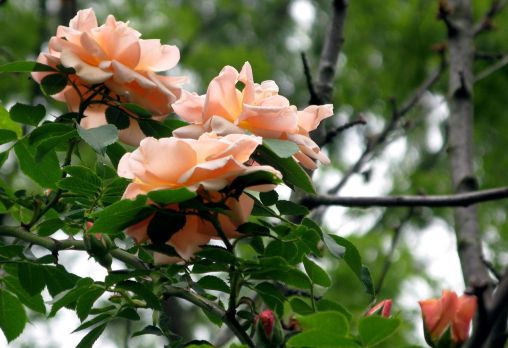
Saturday, June 2. 2007
A reader sent in these nice rattlers caught outside Kingsville, TX., near the natural gas plant. I hope they are planning on eating them...or at least making a belt out of the skin. 
Thursday, May 31. 2007
A propos of the post of the WSJ article yesterday about the Greenies who want to get rid of the Klamath River dams, here is a photo essay of what one of those dam projects, the Boyle Dam, has done to the Klamath river. It isn't pretty. Photo below of the Boyle Dam. 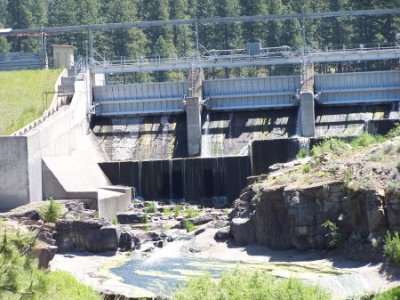
|




 We posted this
We posted this  Yes, unlike the Musk Ox, the Yak is a bovine, and a cousin of the ancestor of our Western domestic cattle, the mighty Auroch.
Yes, unlike the Musk Ox, the Yak is a bovine, and a cousin of the ancestor of our Western domestic cattle, the mighty Auroch.


 For two examples we like, JFK's
For two examples we like, JFK's 

 All summer we see and hear the sturdy
All summer we see and hear the sturdy  We linked the
We linked the  We have written many times about how using ethanol (alcohol, aka moonshine) as a gas additive is a scam, and nothing more than a massive farm subsidy which is raising the cost of food.
We have written many times about how using ethanol (alcohol, aka moonshine) as a gas additive is a scam, and nothing more than a massive farm subsidy which is raising the cost of food. 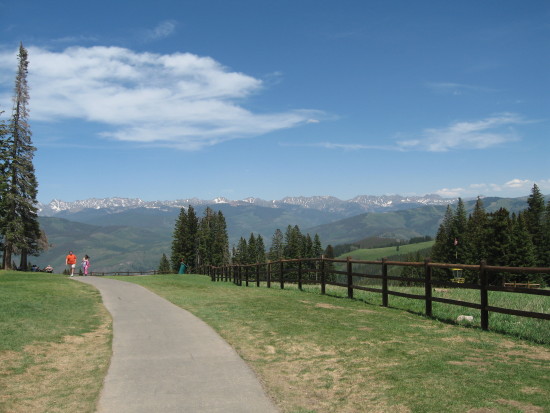
 The return of the Bald Eagle is a
The return of the Bald Eagle is a 
 750 lb. male Griz
750 lb. male Griz  Maggie's Farm supports and admires the work of
Maggie's Farm supports and admires the work of 
 Now that we are in June, our birds would rather eat bugs than seeds. Regardless, I am continuing the feeder this summer to see who stops by. Today: Purple Grackles, Mourning Doves in droves, Goldfinch, Redwing Blackbird, Cowbird, House Finch, House Sparrow, Blue Jay, Cardinal, Tufted Titmouse. Oh - of course, Grey Squirrels.
Now that we are in June, our birds would rather eat bugs than seeds. Regardless, I am continuing the feeder this summer to see who stops by. Today: Purple Grackles, Mourning Doves in droves, Goldfinch, Redwing Blackbird, Cowbird, House Finch, House Sparrow, Blue Jay, Cardinal, Tufted Titmouse. Oh - of course, Grey Squirrels. From the National Research Council (h/t
From the National Research Council (h/t 

